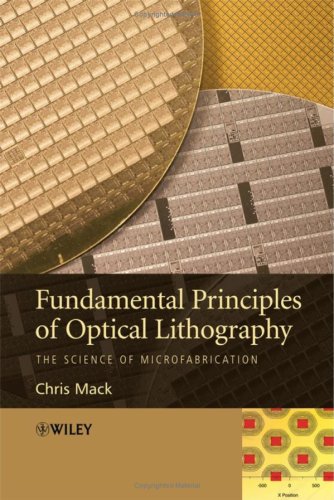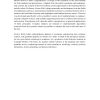(EBOOK PDF)Fundamental Principles of Optical Lithography The Science of Microfabrication 1st Edition by Chris Mack 9781119965077 1119965071 full chapters
$50.00 Original price was: $50.00.$35.00Current price is: $35.00.
Fundamental Principles of Optical Lithography The Science of Microfabrication 1st Edition by Chris Mack – Ebook PDF Instant Download/Delivery: 9781119965077, 1119965071
Full download Fundamental Principles of Optical Lithography The Science of Microfabrication 1st Edition after payment

Product details:
• ISBN 10:1119965071
• ISBN 13:9781119965077
• Author:Chris Mack
Fundamental Principles of Optical Lithography
The Science of Microfabrication
The fabrication of an integrated circuit requires a variety of physical and chemical processes to be performed on a semiconductor substrate. In general, these processes fall into three categories: film deposition, patterning, and semiconductor doping. Films of both conductors and insulators are used to connect and isolate transistors and their components. By creating structures of these various components millions of transistors can be built and wired together to form the complex circuitry of modern microelectronic devices. Fundamental to all of these processes is lithography, ie, the formation of three-dimensional relief images on the substrate for subsequent transfer of the pattern to the substrate. This book presents a complete theoretical and practical treatment of the topic of lithography for both students and researchers. It comprises ten detailed chapters plus three appendices with problems provided at the end of each chapter. Additional Information: Visiting http://www.lithoguru.com/textbook/index.html enhances the reader’s understanding as the website supplies information on how you can download a free laboratory manual, Optical Lithography Modelling with MATLAB®, to accompany the textbook. You can also contact the author and find help for instructors.
Fundamental Principles of Optical Lithography The Science of Microfabrication 1st Table of contents:
1: Introduction to Semiconductor Lithography
1.1 Basics of IC Fabrication
1.2 Moore’s Law and the Semiconductor Industry
1.3 Lithography Processing
Problems
References
2: Aerial Image Formation–The Basics
2.1 Mathematical Description of Light
2.2 Basic Imaging Theory
2.3 Partial Coherence
2.4 Some Imaging Examples
Problems
References
3: Aerial Image Formation – The Details
3.1 Aberrations
3.2 Pupil Filters and Lens Apodization
3.3 Flare
3.4 Defocus
3.5 Imaging with Scanners Versus Steppers
3.6 Vector Nature of Light
3.7 Immersion Lithography
3.8 Image Quality
Problems
References
4: Imaging in Resist: Standing Waves and Swing Curves
4.1 Standing Waves
4.2 Swing Curves
4.3 Bottom Antireflection Coatings
4.4 Top Antireflection Coatings
4.5 Contrast Enhancement Layer
4.6 Impact of the Phase of the Substrate Reflectance
4.7 Imaging in Resist
4.8 Defining Intensity
Problems
References
5: Conventional Resists: Exposure and Bake Chemistry
5.1 Exposure
5.2 Post-Apply Bake
5.3 Post-exposure Bake Diffusion
5.4 Detailed Bake Temperature Behavior
5.5 Measuring the ABC Parameters
Problems
References
6: Chemically Amplified Resists: Exposure and Bake Chemistry
6.1 Exposure Reaction
6.2 Chemical Amplification
6.3 Measuring Chemically Amplified Resist Parameters
6.4 Stochastic Modeling of Resist Chemistry
Problems
References
7: Photoresist Development
7.1 Kinetics of Development
7.2 The Development Contrast
7.3 The Development Path
7.4 Measuring Development Rates
Problems
References
8: Lithographic Control in Semiconductor Manufacturing
8.1 Defining Lithographic Quality
8.2 Critical Dimension Control
8.3 How to Characterize Critical Dimension Variations
8.4 Overlay Control
8.5 The Process Window
8.6 H–V Bias
8.7 Mask Error Enhancement Factor (MEEF)
8.8 Line-End Shortening
8.9 Critical Shape and Edge Placement Errors
8.10 Pattern Collapse
Problems
References
9: Gradient-Based Lithographic Optimization: Using the Normalized Image Log-Slope
9.1 Lithography as Information Transfer
9.2 Aerial Image
9.3 Image in Resist
9.4 Exposure
9.5 Post-exposure Bake
9.6 Develop
9.7 Resist Profile Formation
9.8 Line Edge Roughness
9.9 Summary
Problems
References
10: Resolution Enhancement Technologies
10.1 Resolution
10.2 Optical Proximity Correction (OPC)
10.3 Off-Axis Illumination (OAI)
10.4 Phase-Shifting Masks (PSM)
10.5 Natural Resolutions
Problems
References
Appendix A: Glossary of Microlithographic Terms
Appendix B: Curl Divergence Gradient Laplacian
B.1 Cross Product
B.2 Dot Product
B.3 Curl
B.4 Divergence
B.5 Gradient
B.6 Laplacian
B.7 Some Useful Identities
B.8 Spherical Coordinates
Appendix C: The Dirac Delta Function
C.1 Definition
C.2 Properties and Theorems
Index
People also search for Fundamental Principles of Optical Lithography The Science of Microfabrication 1st:
fundamental principles of optical
chris mack fundamental principles of optical lithography
fundamental principles of optical lithography pdf
fundamental principles of optical lithography pdf download
basic principles of optics
Tags:
Fundamental Principles,Optical Lithography,Chris Mack



